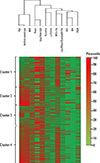Abstract
Purpose
Methods
Results
Figures and Tables
Fig. 1
A heap map. Hierarchical cluster analysis of 259 subjects using 12 parameters: age at enrollment, age at asthma onset, BMI, atopy, log total IgE, duration of asthma, ΔFEV1, FEV1 (% predicted), log bood eosinophils (%), sex, smoking history, and PC20. Red color indicates 100% and green color indicates 0%. The gradations of the 2 colors indicate the range from 0% to 100%. BMI, body mass index; IgE, immunoglobulin E; FEV1, forced expiratory volume in 1 second; ΔFEV1, short acting bronchodilator-induced percentage increase in FEV1; PC20, provocation concentration of methacholine inducing a 20% decrease in FEV1.

Fig. 2
Comparison of the corticosteroid dose and exacerbation frequency during follow-up. The dosages of inhaled corticosteroids (A) and systemic corticosteroids (B) are presented as fluticasone equivalents (µg/day) and prednisone equivalents (mg/year), respectively. The annual rate of exacerbation (C) was calculated as the total number of exacerbations divided by the follow-up duration (years). The subject numbers were 72 (C1), 48 (C2), 52 (C3), and 87 (C4). Box plots show the median values with interquartile ranges. P values were obtained using the Mann-Whitney U test. C1, cluster 1; C2, cluster 2; C3, cluster 3; C4, cluster 4.

Fig. 3
Kaplan-Meier plots of the accumulation risk of the first (A) and second (B) exacerbations. Y-axis, accumulation rate of exacerbation; X-axis, time to exacerbation. P values were obtained using the χ2 test.

Table 1
Clinical and demographic characteristics of the study subjects

BMI: body mass index, FEV1: forced expiratory volume in 1 second, ΔFEV1: short acting bronchodilator-induced percentage increase in FEV1, PC20: provocation concentration of methacholine inducing a 20% decrease in FEV1. All values are presented as medians with ranges. The normality of the distribution was evaluated using the Shapiro-Wilk test. The Kruskal-Wallis test was used to compare variables among the groups, and P values are presented in the right hand column. Post hoc analyses using Mann-Whitney U tests were performed for comparisons of two groups. The chi-squared test was used to compare qualitative variables. *C1 vs C2 (P<0.05); †C1 vs C3 (P<0.05); ‡C1 vs C4 (p<0.05); §C2 vs C3 (p<0.05); ∥C2 vs C4 (P<0.05); ¶C3 vs C4 (P<0.05).
Table 2
Dosages of the corticosteroids used and exacerbation rates in the study subjects

*Dosages of inhaled corticosteroid are presented as fluticasone equivalents (µg/day), calculated as the total amount of inhaled corticosteroids during the first year after the initial visit. †Dosages of systemic corticosteroid are presented as prednisone equivalents (mg/year), calculated as the total amount of prednisone during the first year after the initial visit, *, †, ‡ All values are presented as medians with ranges. Other data are presented as the numbers of subjects (% of the total subjects or subtotal in each cluster). The Kruskal-Wallis test was used to compare the variables among groups, and P values are presented in the right hand columns. Post hoc analysis using the Mann-Whitney U test was performed to compare two groups. §C1 vs C2 (P<0.05); ∥C1 vs C3 (P<0.05); ¶C1 vs C4 (P<0.05); **C2 vs C3 (P<0.05); ††C2 vs C4 (P<0.05); ‡‡C3 vs C4 (P<0.05).




 PDF
PDF ePub
ePub Citation
Citation Print
Print



 XML Download
XML Download